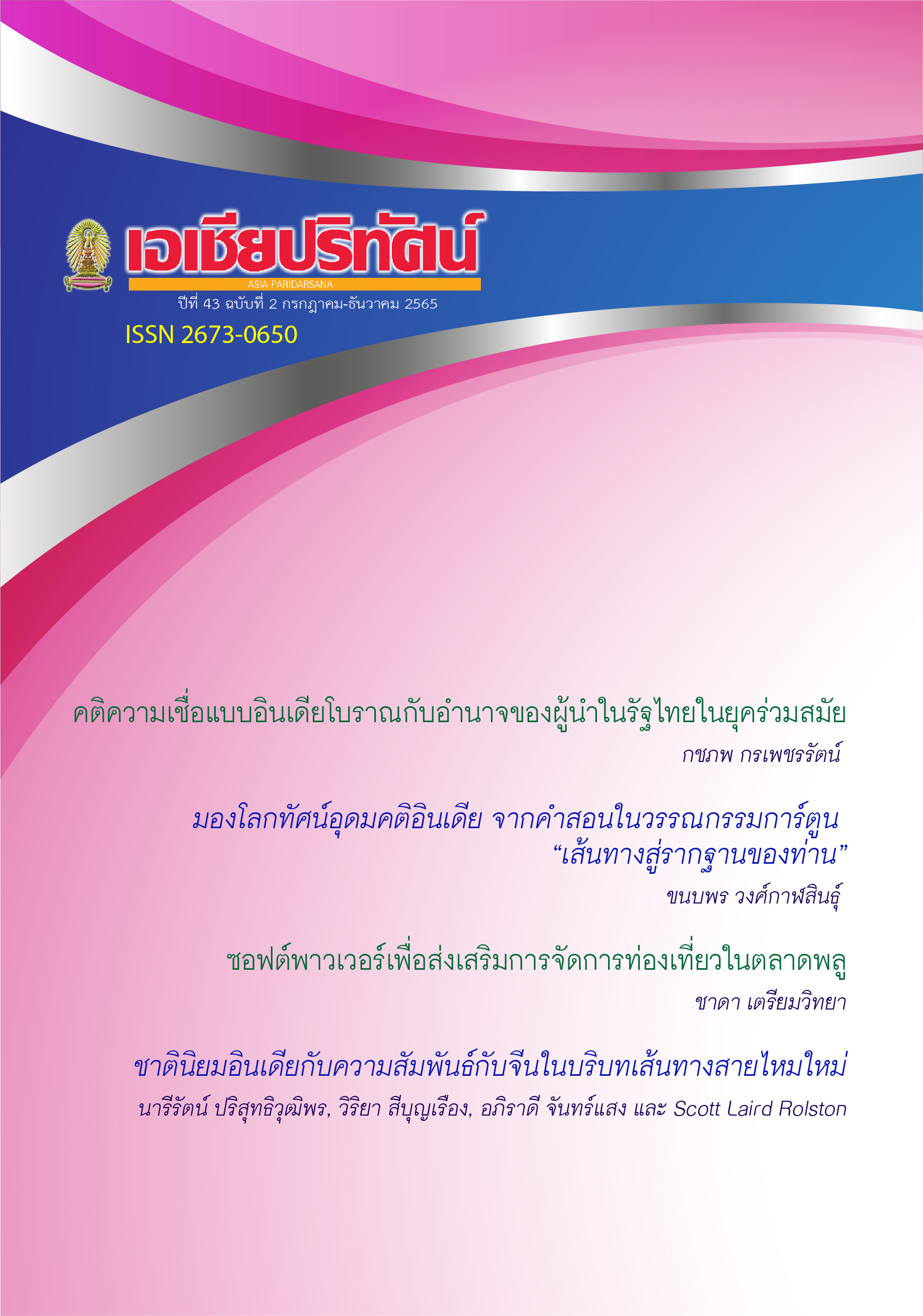The Shadow of Indic Ideology in Political Power Expression in Contemporary Thailand.
Main Article Content
Abstract
This article aims to study the expression of power by Indic ideology in the current Thai modern state through national and local ceremonies related to modern state leaders. To understand the meaning of power expression and the phenomena, the Theatre State theory introduced by Clifford Geertz, an anthropologist who observed the rituals in Bali, Indonesia, was applied in the analysis of this article. Based on his research and observation, he perceived the ritual which was not just a sacred ceremony but also a great drama scene that was able to transform the intangible concept of power into tangible reality. AlthoughThailand has changed the government and political structure since 1932, from a traditional state to a modern state, various ancient Indic rituals related to the leader are still practiced, mainly in order to improve the image of national and local political institutions.
Article Details

This work is licensed under a Creative Commons Attribution-NonCommercial-NoDerivatives 4.0 International License.
บทความทุกบทความเป็นลิขสิทธิ์ของสถาบันเอเชียศึกษา ดูตัวอย่างอื่นประกอบReferences
ภาษาไทย
ชาตรี ประกิตนนทการ. 2552. ศิลปะ-สถาปัตยกรรมคณะราษฎร: สัญลักษณ์ทางการเมืองในเชิงอุดมการณ์. กรุงเทพฯ:
มติชน
เชษฐ์ ติงสัญชลี. 2560.เมรุ ในศิลปะอินเดีย. สำนักงานคณะกรรมการการศึกษาขั้นพื้นฐาน กระทรวงศึกษาธิการ คณะ
ศิลปศาสตร์ มหาวิทยาลัยธรรมศาสตร์ และ มิวเซียมสยาม.ศูนย์สื่อและสิ่งพิมพ์แก้วเจ้าจอม มหาวิทยาลัยราช
ภัฏสวนสุนันทา.
เติม วิภาคย์พจนกิจ. 2530. ประวัติศาสตร์อีสาน. กรุงเทพฯ : มหาวิทยาลัยธรรมศาสตร์
ธรีวัฒน์ แสนคำ. 2560. งานพระศพกษัตริย์ล้านช้างในสมัยรัฐจารีต. สำนักงานคณะกรรมการการศึกษาขั้นพื้นฐาน
กระทรวงศึกษาธิการ คณะศิลปศาสตร์ มหาวิทยาลัยธรรมศาสตร์ และ มิวเซียมสยาม.ศูนย์สื่อและสิ่งพิมพ์แก้ว
เจ้าจอม มหาวิทยาลัยราชภัฏสวนสุนันทา.
บาทหลวงตาชารด์. 2551. จดหมายเหตุการเดินทางสู่ประเทศสยามครั้งที่ 1 และจดหมายเหตุการเดินทางครั้งที่ 2. แปล
โดย สันต์ ท. โกมลบุตร.พิมพ์ครั้งที่ 1. กรุงเทพฯ : ศรีปัญญา.
ปกรณ์ ปุกหุต.2558. “พิธีกรรมนกหัสดีลิงค์ ณ ทุ่งศรีเมือง ปี พ.ศ. 2558 : การเปลี่ยนแปลงจารีตตามบริบทปัจจุบัน” .
จดหมายข่าวศูนย์วิจัยสังคมอนุภูมิภาคลุ่มน้ำโขง คณะศิลปศาสตร์ มหาวิทยาลัยอุบลราชธานี ฉบับ “ต้อนรับ
AC เปรมปรีดิ์ทั่วภูมิภาค”. 2, 2 (กรกฎาคม – ธันวาคม 2558): 26– 38.
โรเจอร์ แมนลีย์.2504.ประชุมพงศาวดาร ภาคที่ 76 จดหมายเหตุของโยส เซาเต็น พ่อค้าชาวฮอลันดาในสมัยพระเจ้า
ทรงธรรมและพระเจ้าปราสาททอง.แปล โดย ขจร สุขพานิช. กรุงเทพฯ : ชุมนุมช่าง
พระมหากวีศักดิ์ ญาณกวิ (วาปีกุลเศรษฐ์). 2562. “กษัตริย์ในอุดมคติตามแนวคิดในมหาภารตะและรามายณะที่ปรากฏ
ในจารึกแม่บุญ ตะวันออกและจารึกแปรรูปของพระเจ้าราเชนทรวรมันที่ 2”.วรสารวิจยวิชาการ.ฉบับที่ 1.
พิพัฒน์ กระแจะจันทร์. 2562. “การงดและรื้อฟื้นเรือพระราชพิธีหลัง 2475: นัยของอำนาจและความศักดิ์สิทธิ์ของชนชั้น
นำ.” THE STANDARD: the standard.co/royal-barge-procession-after-2475/
รสิตา สินเอกเอี่ยม. 2561. “The Paradigm of the Sacred Mountain Designs in Southeast Asian Culture/ กระบวน
ทัศน์การออกแบบภูเขาศักดิ์สิทธิ์ในวัฒนธรรมเอเชียตะวันออกเฉียงใต้”. หน้าจั่ว: วารสารวิชาการคณะ
สถาปัตยกรรมศาสตร์.มหาวิทยาลัยศิลปากร. ฉบับ15
วิราณี แว่นทอง. 2551. “การรำในพิธีทำศพแบบนกหัสดีลิงค์ในอุบลราชธานี”. วิทยานิพนธ์ปริญญาศิลปศาสตรมห
บัณฑิต สาขาวิชานาฏยศิลป์ไทย ภาควิชานาฏยศิลป์ไทย คณะศิลปกรรมศาสตร์, จุฬาลงกรณ์มหาวิทยาลัย.
ศานติ ภักดีคำ. 2562.พระเสด็จโดยแดนชล เรือพระราชพิธีและขบวนพยุหยาตราทางชลมารค. กรุงเทพฯ : มติชน
สุจิตต์ วงษ์เทศ. 2559. "วัฒนธรรมร่วม" ในอุษาคเนย์ รากเหง้าเก่าแก่ของประชาคมอาเชียน. กรุงเทพฯ : นาตาแฮก
สุวิทย์ ธีรศาศวัต. 2557. ประวัติศาสตร์อีสาน 2322-2488. ขอนแก่น : ศูนย์วิจัยพหุลักษ์สังคมลุ่มน้ำโขง
มหาวิทยาลัยขอนแก่น.
อชิรัชญ์ ไชยพจน์พานิช.2557. ศิลปะเวียดและจาม.พิมพ์ครั้งที่ 1.กรุงเทพฯ:สำนักพิมพ์มติชน
ภาษาต่างประเทศ
Baker, C. J., & Phongpaichit, P. 2018. A history of Thailand. Cambridge : Cambridge University Press.
Berkeley. CA: University of California Press. Chan, H.-lam.1981. “Ideologies and Traditions of Monarchy and Government in Imperial China”. Kingship In
Asia and Early America.179–216.
Coedès, G., Cowing, S. B., & Vella, W. F.1996. The Indianized States of Southeast Asia.
Diskul, M. C. S. 1981. “Ancient Kingship in Mainland Southeast Asia”. Kingship In Asia and Early America,
–160.
Geertz, C. 2010. Negara: The theatre state in nineteenth-century Bali. New Jersey : Princeton Univ Press.
Hall, K. R. 1984. “Small Asian Nations in the Shadow of the Large: Early Asian History through the Eyes of
Southeast Asia”.Journal of The Economic and Social History of The Orient
Hall, K. R. 2019. “The “Indianization” of Funan: Southeast Asia’s First State”. Maritime Trade and State
Development in Early Southeast Asia. 52–84. Honolulu: Univ. of Hawaii Press
Manning, J. G. 2012. Hydraulic civilization. The Encyclopedia of Ancient History.
Phillips, Matthew. 2017. “Ancient Past. Modern Ceremony: Thailand’s Royal Barge Procession in Historical
Context”. In How the Past was Used: Historical Cultures c. 750-2000. edited by Peter Lambert and
Björn Weiler, 201-30. Oxford: Oxford University Press.
Roy, E. V. 2011. Rise and fall of the Bangkok mandala (Vol. 45). Wiesbaden : Harrassowitz Verlag.
Strate, S. 2015. “The lost territories: Thailand’s history of national humiliation”. The Eyes of Southeast Asia.
Journal of the Economic and Social History of the Orient. 27(1):56. Honolulu : University of Hawaii
Press.
Weber, M. 1978. Economy and Society: An Outline of Interpretive Sociology. 2 Vols.
Wolters, O. W. 2005. History, culture, and region in Southeast Asian perspectives. ACLS History E-Book
Project.


